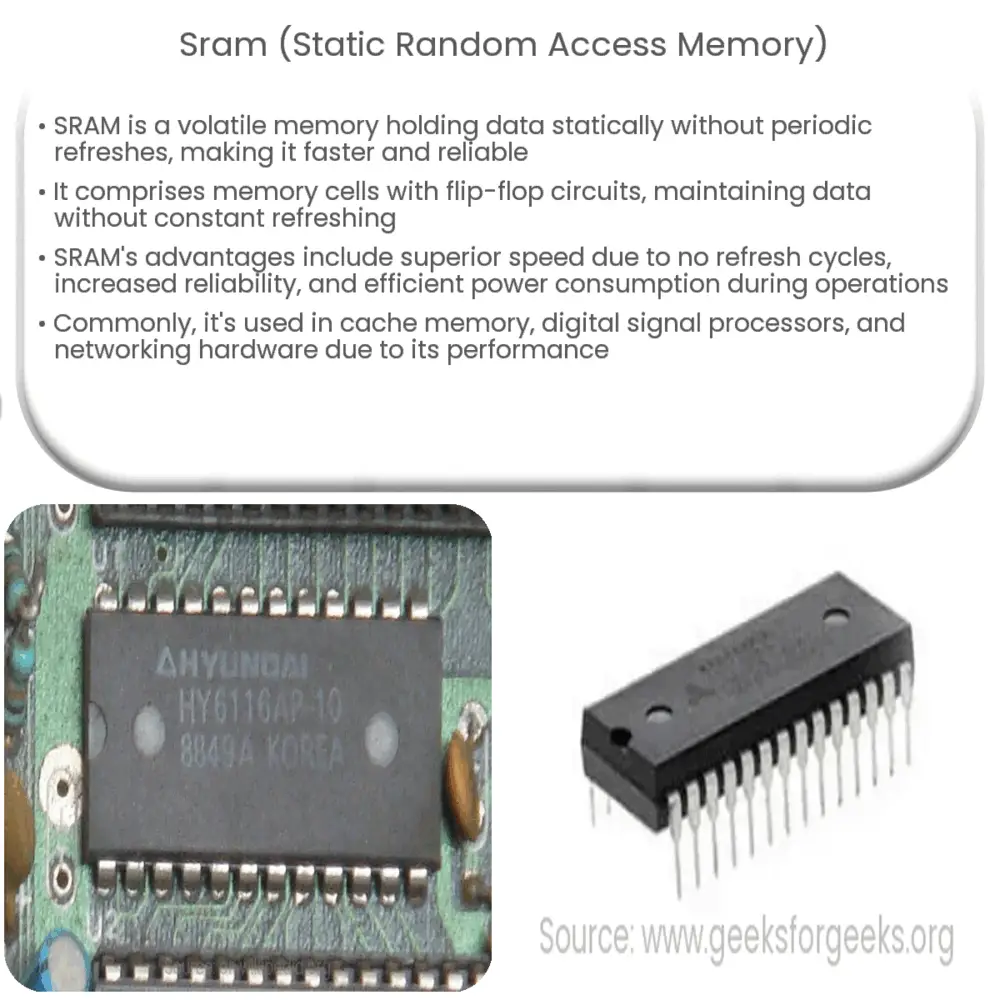Explore the world of Static Random Access Memory (SRAM), its working principle, advantages, applications, and comparison with DRAM.

Introduction to SRAM
Static Random Access Memory, popularly known as SRAM, is a type of volatile memory that holds data in a static state, as long as the computer system is powered on. Unlike DRAM, which needs to be refreshed periodically, SRAM maintains data integrity without needing to be refreshed, making it faster and more reliable.
Working Principle of SRAM
SRAM consists of several memory cells, each containing a flip-flop circuit, which enables it to maintain data state without the need for constant refreshing. This characteristic is the reason behind the ‘Static’ part of its name. It is also the reason why SRAM is more expensive than other types of volatile memory.
- Write Operation: During a write operation, the data bit is written into the cell by changing the state of the flip-flop circuit.
- Read Operation: In a read operation, the state of the flip-flop circuit is checked, thereby retrieving the stored data bit.
Advantages of SRAM
Several features make SRAM an advantageous choice in various applications. They include:
- Speed: SRAM is significantly faster than other types of volatile memory, such as DRAM. This is due to the absence of a need for constant refresh cycles.
- Reliability: The design of SRAM makes it more reliable, with less chance of data corruption.
- Power Consumption: Despite consuming more power in a standby state, SRAM uses less power during read and write operations, making it suitable for applications where power efficiency is crucial.
Applications of SRAM
Due to its high cost and superior performance, SRAM is often used in applications where speed is crucial, and the cost is not a limiting factor. Some common applications are:
- Cache memory in processors
- Fast memory for digital signal processors
- Networking hardware
Overall, SRAM plays an essential role in modern computing and electronics. Its superior speed and reliability make it a crucial component in a variety of devices.
Different Types of SRAM
There are several types of SRAM based on their internal structure and functionality, including:
- Asynchronous SRAM: This type of SRAM does not operate in sync with the clock speed of the CPU. It was widely used in older systems but is less common in modern technology.
- Synchronous SRAM: This type of SRAM operates in sync with the CPU clock, making it faster and more efficient. It is commonly used in modern systems.
- Zero Bus Turnaround SRAM: This advanced SRAM variant allows immediate data transfers without waiting for the bus to turn around, greatly increasing its speed.
SRAM vs. DRAM
The two main types of RAM used in computing are SRAM and Dynamic RAM (DRAM). While both are volatile memory types, they have significant differences:
- Speed: SRAM is faster than DRAM because it does not require periodic refreshing.
- Complexity and Cost: SRAM is more complex in design and costlier to produce than DRAM.
- Size: SRAM cells are larger than DRAM cells, leading to less memory per chip.
- Power Usage: SRAM uses less power during operation but more in standby mode, while DRAM uses more power during operation but less in standby mode.
Conclusion
In conclusion, Static Random Access Memory (SRAM) is a critical component of modern computing systems. Its speed and reliability, coupled with its lower power usage during operation, make it a preferred choice for applications where these attributes are of high importance, such as in cache memory, digital signal processors, and networking hardware. Despite its higher cost and complexity, the benefits of SRAM often outweigh these challenges. The continuous advancements in technology promise to enhance the features and reduce the limitations of SRAM, making it an even more integral part of the future of computing.

